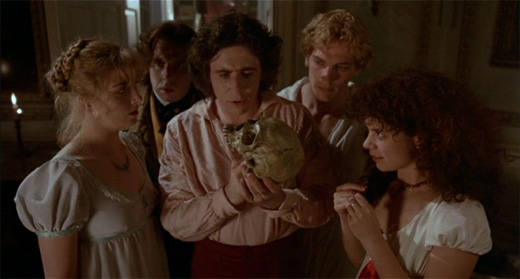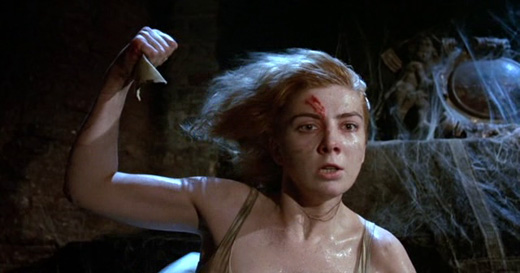
Written by Stephen Volk
Directed by Ken Russell
UK, 1986
Natasha Richardson (in her leading role debut) plays Mary Godwin, later Mary Shelley, in Ken Russell’s fictionalised take on the inception of both her classic novel Frankenstein and John Polidori’s The Vampyre. It is based on the Shelleys’ visit with Lord Byron at Villa Diodati, on the shores of Lake Geneva, where there was a famous challenge among the collected guests to write a horror story; this event was notably portrayed on film in the opening of James Whale’s The Bride of Frankenstein. Befitting of his stylistic trademarks, Russell’s version of events is a demented concoction of sex, hysteria, fear and hallucinatory dreamscapes.
One summer evening in 1816, Percy Shelley (Julian Sands) and Mary arrive by boat at the lakeside estate of Lord Byron (Gabriel Byrne), with Mary’s cousin Claire (Miriam Cyr) in tow, who is secretly pregnant with Byron’s illegitimate child. Also present is Dr. Polidori (Timothy Spall), a sexually repressed literary acquaintance of Byron. The night begins with drinking and mind games, eventually leading to a séance attempt involving a skull, following which all members of the group begin to experience vivid, distinctly personal hallucinations. Mary, for example, is plagued by images of her miscarried child, while Percy finds himself seemingly face-to-face with an image from his dreams; due to mistrust of his ways, Byron is also portrayed as a vampiric figure after the séance. The group begins to suspect that their communal fears and anxieties have spawn a physical manifestation lurking on the grounds, something they must vanquish before the night is through.
Ken Russell uses imagery in cinema in a fashion often more akin to both theatre and painting, and Gothic’s most effective elements are unsurprisingly found in its visual construction. The oddity and nastiness of its imagery leave a strong impression, even when scored by an often distractingly abrasive electronic score from Thomas Dolby. Some of the film’s dialogue feels a little on the nose, particularly in regards to material that will form the basis of Frankenstein, though some of that, like a discussion of the titan Prometheus referenced in Shelley’s novel’s full title, have charm. Gothic is a vivid, hyperbolic work that often feels more silly than striking, but the lunacy on display does have bursts of great appeal. It is not one of Russell’s best films but it is certainly, at the very least, an interestingly unique exploration of fear, and of modern horror’s inception as filtered through a maverick director’s mind.
Josh Slater-Williams


